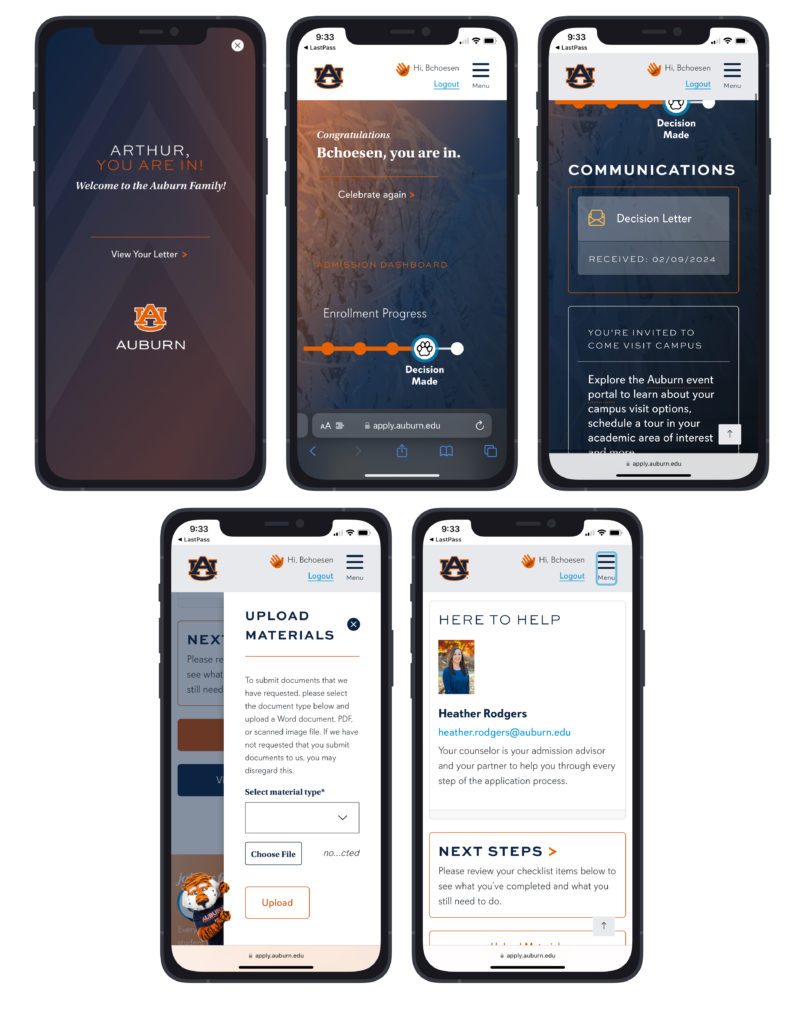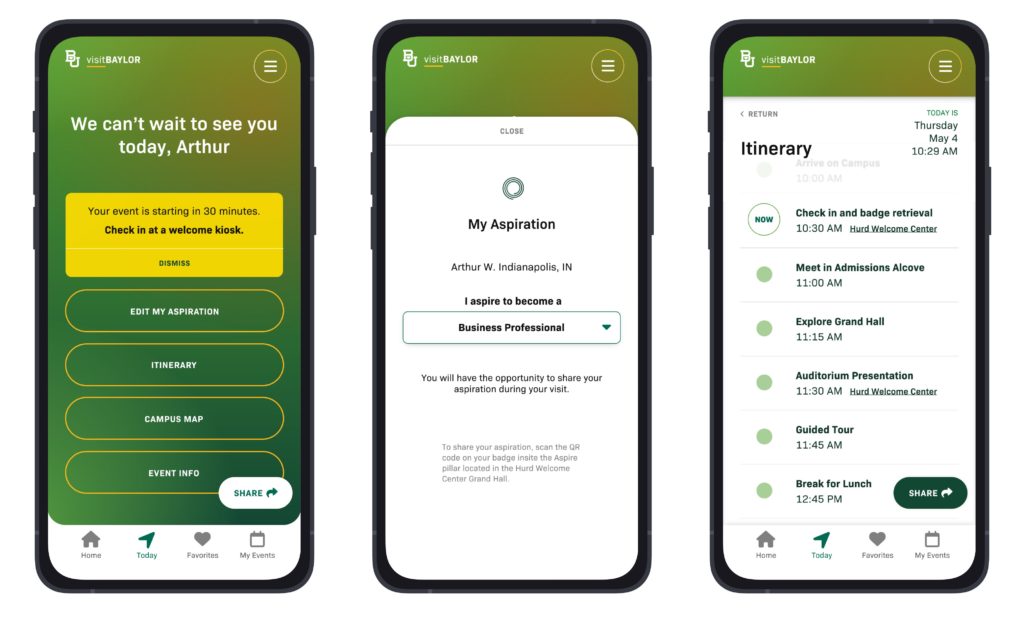Campus Visits Part II: Creating a Seamless Digital-to-Physical Campus Visit Experience
In our last piece on rethinking and redesigning your campus visit experience, we explored ways to enhance the persuasive power of an in-person visit. Prospective students and their supporters deserve a welcoming, informative and compelling experience—one that acknowledges the effort and investment they make to step onto campus.
But how to get them there in the first place? How do you effectively close the distance between prospective student curiosity and your campus through digital modes?
And how can you combine digital and IRL modes to build on the work you’re doing to rethink the on-campus visit experience?
We ask these questions to invoke a truth that is simple, yet profound: the first contact many prospective students and supporters will have with your campus will happen in a digital space. What you present in that space—your digital campus—should be as intentionally designed and well tended as your physical campus.
In this piece, we’ll recap case studies in which RHB helped teams at two universities—Auburn and Baylor—create digital experiences that gave prospective students and their families convenient, customized and compelling access to those campuses. Then, three RHB colleagues will share tips and points of consideration to guide your own efforts to align your in-person and digital campus experiences. Remember: whether digital or on the ground, it’s all human experience.
Building Family through Portal and Print at Auburn
Auburn University partnered with RHB to create a seamless, inspiring journey for prospective students—one that truly reflected the warmth and tradition of the Auburn Family. Our intensive research showed that while campus visits felt personal, welcoming and highly persuasive, the digital and print materials that wrapped around those in-person experiences lacked that ease and warmth. The visit registration website was difficult to navigate, requiring multiple clicks to schedule a tour, and the printed brochure was bogged down with procedural details, missing the personal touch that defines Auburn’s campus experience.
RHB set out to address these points of incoherence by designing a cohesive, multi-platform experience that made every step—from registering for a visit to applying for admission—intuitive, engaging and aligned with being a part of the Family.
The solution included a streamlined campus visit portal that simplified tour registration, a refreshed visit brochure that mirrored the warmth and intimacy of in-person experiences, and an applicant portal that kept students informed throughout the admissions process. The new admitted student packet captured the excitement of joining the Auburn community, incorporating beloved campus traditions like the Auburn Creed and rolling Toomer’s Corner.
These updates ensured that every interaction with Auburn—whether online, in print, or in person—felt distinctly Auburn. Now, prospective students don’t just learn about Auburn’s spirit; they experience it from the very first click.
Learn more about our work with Auburn
The Power of Personalization with visitBaylor
When Baylor University unveiled the Mark and Paula Hurd Welcome Center—a state-of-the-art gateway to campus—they turned to RHB to craft an admissions experience as innovative and inviting as the building itself. (If you get a chance, you should experience this invitation at night: the building’s four 96-foot-tall pillars glow an attention-getting green—welcoming lights reach out to passers-by to speak of the University’s commitment to a Christian understanding of hospitality: “Hospitality is both action and affection, receiving and loving a stranger.”)
Our challenge? Design a seamless digital campus visit planning tool for prospective students that matched the marvel of the Hurd Center and the feeling of Baylor’s deep hospitality. To do that, RHB needed to integrate customized digital interactions, simplify event registration and ensure the experience felt as warm and engaging as a face-to-face welcome.
The result was visitBAYLOR, a unified portal that streamlines the entire admissions visit, from easy event browsing to personalized itineraries and real-time campus engagement. Visitors spend time in all of the Hurd Center’s four pillars—Aspire, Connect, Reflect, and Amplify—each designed to immerse them in the Baylor experience. The Aspire Pillar even displays students’ aspirations alongside their name and hometown, conveying how well Baylor already knows them.
With QR code check-ins, on-demand badge printing and interactive displays that highlight connections between visitors, every prospective student experiences a deeply personalized journey. Controlled through Slate, the system allows Baylor to update content effortlessly, ensuring future adaptability. More than just a logistical tool, visitBAYLOR ensures that students know they have been seen, understood and known.
Get the full visitBAYLOR story
The Baylor and Auburn examples convey the power of intentionally combining well-tended digital and physical campuses with the power of authentic emotional and missional alignment. What do you need to consider when you are ready to create something truly special on your campus(es)? Some of RHB’s talented Slate and Related Technologies team members offer advice to get you started wherever you are in your own journey.
Bring Emotion and Coherence to the Digital Space
Associate Director of Design and Development Alisa Chambers highlights the importance of using verbal and visual modes to craft a truly inclusive experience:
- Use storytelling to convey institutional values and foster a sense of belonging.
- Balance simplicity and depth in information, ensuring accessibility and ease of use.
- Ensure virtual experiences are accessible, incorporating screen-reader-friendly content and intuitive navigation.
Alisa’s advice makes explicit an important fact: every human experiences technology differently. We don’t all use shared tools the same way, and what appeals or is useful to us can be highly individual. Propensities, interests and abilities differ. That means you have an opportunity to think about digital tools as the means to expand both interest and welcome. Create coherence in imagery—show authentic interactions, not just empty buildings. Offer first-hand stories and student perspectives to provide a human touch in the absence of an in-person guide. Design your systems to serve the students, not the reverse.
Alisa also suggests that you remind students that this is the first step in a longer journey with you that will continue traversing the digital realm: showcase digital demonstrations of campus technologies they will use as current students, such as learning management systems and student portals. This will help prospective students follow the path from the current tool into exploring others in the future.
Understand Audience Needs, Empower Their Agency
Senior Technology Consultant John Michael Cuccia (JMC) advises you to ask, not assume:
- What does your digital audience want to see and know? Recall that prospective students and parents may have different wants.
- What challenges do prospective students face in navigating your digital and physical environments? How well have you developed way-finding digitally and on your physical campus?
- What in-person elements require thoughtful virtual translation? If someone can’t come to campus what do they need to be able to see well virtually? Your current students and faculty may have great ideas.
JMC also suggests that it can be enlightening to recall a recent experience you had that was positive, seamless and met all your expectations. Compare that to a recent experience that was troublesome, a hassle or confusing. These could be experiences like shopping online or buying concert tickets. Now, look at your prospective student journey wearing your customer hat. What feels seamless and exciting? What feels hard to navigate or makes you want to do something else instead? Which feeling do you want prospective students to carry with them after they interact with you?
And Senior Technology Consultant Brian Choe emphasizes the importance of agency: How can prospective students make the online experience their own? Brian points to your virtual tour as a sometimes-overlooked opportunity to empower students to “choose their own adventure.” A customizable tour, where students select topics that interest them, could shape both their virtual visit and their ongoing engagement through status portals and follow-up content.
“You should be providing the most customized experience possible based on what you know about a person. And for those things you don’t know, you should make it a priority to find out before attempting to deliver an experience to them.”
Create a Human-Centered, Multi-Modal Experience
Ultimately, digital elements of visit design should not be an afterthought but integral tools for how you express welcome and your genuine curiosity about prospective students. By prioritizing the human experience through customization, storytelling, accessibility and audience-informed design, institutions can build a bridge between curiosity and commitment, ensuring that prospective students feel connected long before they set foot on campus.
A last word of advice from JMC: “You should be providing the most customized experience possible based on what you know about a person. And for those things you don’t know, you should make it a priority to find out before attempting to deliver an experience to them.” Curiosity is essential.
If you’re curious about how to maximize your team’s capability and capacity to deliver that customized experience to your prospective students, let us know. We know how important your work is and we are here when you need an assist.



